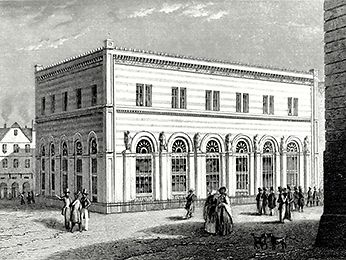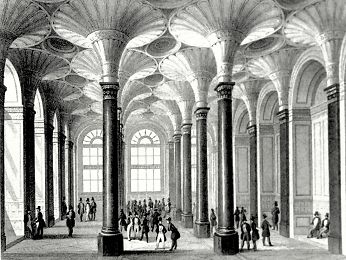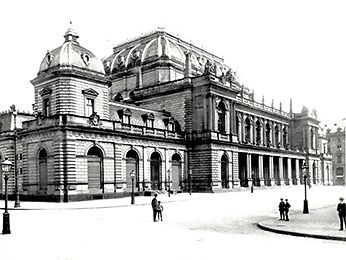Service Navigation
History of the Frankfurt Stock Exchange
History of the Frankfurt Stock Exchange
- Fairs, coins and bills of exchange: 11th - 17th century
- Patricians, princes and commodity markets: 18th - 19th century
- Wars, reconstruction, the computer age and cross-border growth: 20th century
Patricians, princes and commodity markets: 18th - 19th century
The old stock exchange on the Paulsplatz, 1845
© Historisches Museum Frankfurt am Main
In 1808, the Chamber of Commerce was formed out of these Deputies. The stock exchange, which had been established 223 years previously as a private institution operated by a number of merchants, was brought under the umbrella of the Chamber of Commerce. It thus became a public-sector institution.
Trading in government bonds began on the Frankfurt exchange at the end of the eighteenth century. In 1779, Bankhaus Bethmann placed the first bond denominated in the millions for the German Emperor in Vienna. To be in a position to arrange this huge sum, for the first time this bank issued so-called fractional bonds (Partialobligationen) in Frankfurt. Anyone with funds could buy these securities at the bank. The investor thereby actually acquired part of the overall bond issue as well as the right to a share in the regular interest earnings. This instrument of capital mediation that was introduced by Bankhaus Bethmann made it possible for the Frankfurt banks to arrange large bond issues in the future.
With the advancement of Bankhaus Rothschild in Frankfurt to the leading capital intermediary among the European dynasties, the city developed into a centre for international capital with one of the major international stock markets besides London and Paris. The restricted space at the location in Haus Braunfels became less and less appropriate in view of the importance of the stock exchange. For this reason, in the mid-nineteenth century it built its own prestigious building located near the Paulskirche on the Paulsplatz. The building was based on the plans of the Frankfurt architect Friedrich Peiper and opened its doors in 1843.
The old stock exchange on the Paulsplatz, 1845
© Historisches Museum Frankfurt am Main
The first common share – a participating certificate of the Austrian National Bank (Oesterreichische Nationalbank) – had been traded in Frankfurt back in 1820. The main focus of trading on the Frankfurt exchange, however, was still on bonds. In contrast to the other large European stock exchanges, the Frankfurt market was initially cool to the ever more popular shares in numerous stock corporations. Until 1850, the Frankfurt stock exchange primarily developed into a centre for trading in secure government bonds and funds. This specialisation lent Frankfurt the reputation of 'solid Frankfurt'. Frankfurt became the 'gateway for capital exports' because based in this market, foreign bonds were additionally also placed on the other European stock exchanges.
The new exchange building was opened in 1879. In their plans for the building, the well-known Frankfurt architects Heinrich Burnitz and Oskar Sommer succeeded in creating an extremely harmonious combination of functionality and prestige. In addition to the main railway station and the Old Opera, the New Stock Exchange is still one of the most important Frankfurt structures dating from the Wilhelmian era.
The new stock exchange in Frankfurt, 1895
© Historisches Museum Frankfurt am Main
Thanks to the city's good international contacts, during the years after 1871, when Berlin was the capital of the newly founded German Empire and became host to the country's most important stock exchange, Frankfurt was nevertheless able to assert its international position and its role as a central stock exchange. At the end of the 19th century, the absolute necessity of adapting to the general economic situation in the country was recognised in Frankfurt. In order not to endanger its prestige as an economic capital, and contrary to former endeavors, Frankfurt altered its economic policy and strove to attract industry and intensified share trading activities. This development in the direction of a true stock exchange met the challenge of the Berlin Stock Exchange's dominance. The Frankfurt exchange could now offer companies, primarily located in southern Germany, an alternative to Berlin for the raising of capital. The 29 German stock exchanges were only subject to a uniform organisation under the Stock Exchange Act of 1896. In addition, the previous local provisions applicable in Frankfurt gave way to a nationwide arrangement that has remained largely in effect down to this day.


